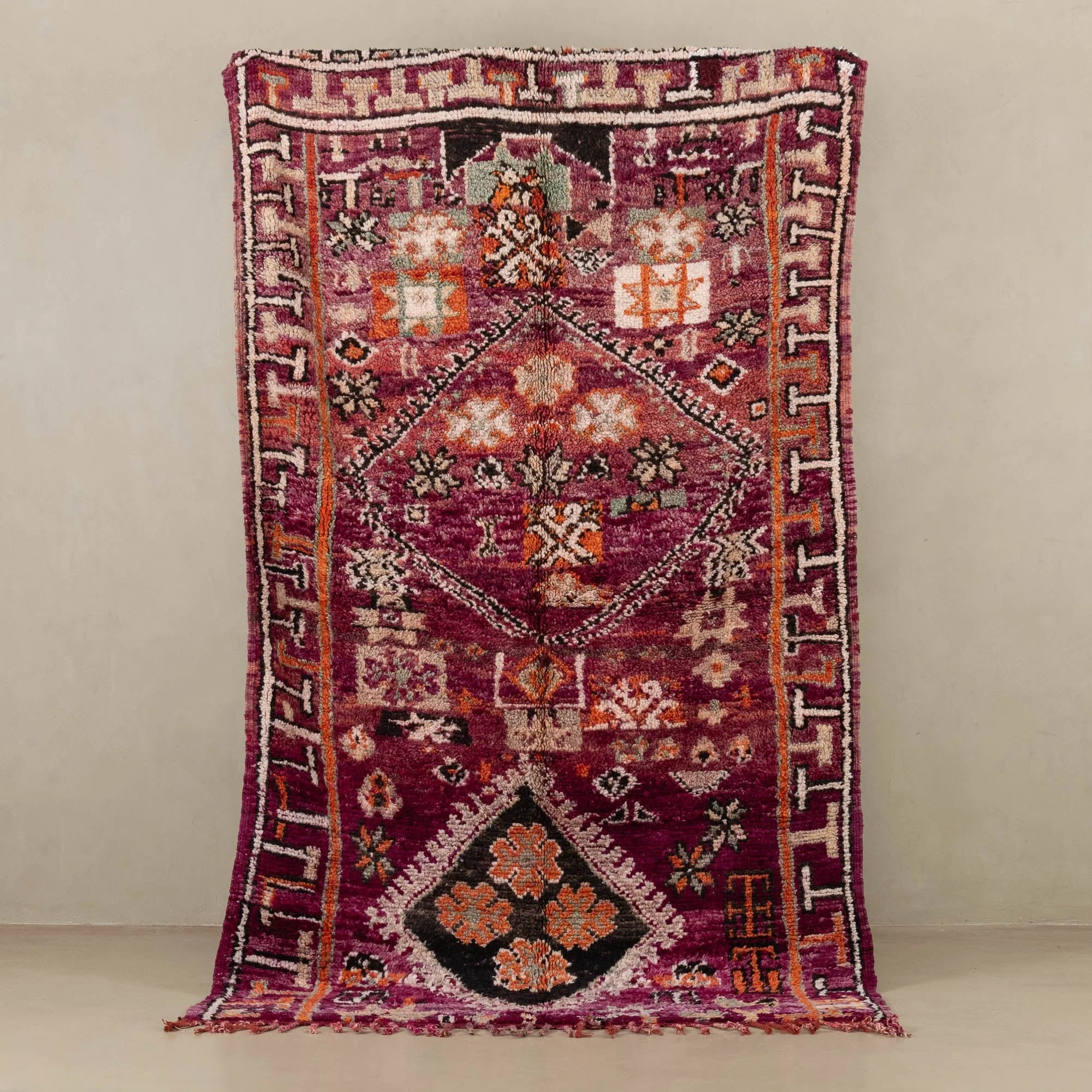 Image 1 of 4
Image 1 of 4

 Image 2 of 4
Image 2 of 4

 Image 3 of 4
Image 3 of 4

 Image 4 of 4
Image 4 of 4





North Star Rug
Details
This gorgeous rug was handwoven decades ago by women if the Boujad tribe in Morrocco. Handmade from 100% natural wool and traditionally traditionally woven with fringe on one only one side, this boldly patterned and vibrantly colored rug will instantly elevate the look and feel of your interior.
Editors' Note
This collection is named for the powerful orator, activist and American hero, Sojourner Truth. Born into slavery as Isabella Baumfree (also, Bomfree or Bomefree) in 1797, on the Ulster County, New York plantation of the “Low Dutch” Ardinburgh family, Truth was part of a large community of enslaved people that had existed in New York since the early 1600s. Beginning first with the Dutch, and later the English as New Amsterdam made its 1664 transition into modern-day New York, slavery grew in the region until by Truth’s time, New York had the second largest enslaved population among the 13 colonies, trailing only South Carolina. The name “Baumfree,” was not a surname, but rather a nickname given to Truth’s father, James, meaning “tree” in Low Dutch, the orator’s first language. She later recalled in her biography that the name referenced her father’s height and posture as a youth. Her mother Betsey, meanwhile, was referred to most commonly as “Mau-mau Bett.” While her parents may have had as many as 12 other children, Sojourner knew only one younger brother, Peter, as the rest — all older — had already been sold. What she did remember, however, was life trapped in the small, dank, cellar of a hotel owned by Charles Ardinbburgh, the son of her family’s original enslaver. Admitting almost no light and with a raw, earthen floor, the room was used to house all those Ardingurgh enslaved on the property regardless of age or gender. And all were subject to extensive disease due to the conditions. Between 1806, when a 9 year-old Isabella was sold to a cruel and abusive Englishman, John Neely in Kingston, New York, and 1826 when she fled from bondage, Truth was sold no less than 3 times, married, and bore 5 children — one, her daughter Diana — the result of an assault by her final enslaver, John Dumont. In 1826, when Dumont reneged on a promise to free Isabella the year before the scheduled 1827 abolition of slavery in the state, she took her youngest daughter, Sophia, then only 3-months old, and escaped to the home of Isaac and Maria Van Wagenen in New Paltz. The Van Wagenens did not believe in slavery, but paid Dumont for her services for the year to ensure her safety. While there, after a lifetime of religious instruction and harrowing experiences, Isabella had a spiritual awakening that led her to become a preacher, and then — 17 years later — to rechristen herself as Sojourner Truth in 1843. Also, in 1828, Truth sued successfully for the return of her son, Peter, whom Dumont had illegally sold into slavery in Alabama. Called by the Spirit to speak the truth, Sojourner began to live as an itinerant preacher, traveling to speak and living with progressive communities such as the Northampton Association of Education and the Progressive Friends. Through these societies she came into contact with many leading abolitionists and suffragists, including William Lloyd Garrison, Lucretia Mott and Frederick Douglass. Known for her sonorous singing voice and the passion of her sermons, Truth became a sought-after speaker for both abolitionist and suffragist stages and a formidable proponent for both causes — particularly after the 1850 release of her autobiography, which was published by Garrison. The 1850s saw some of the highest points of Truth’s career as an orator, including her 1853 speech, What Time of Night It Is, delivered at a New York State meeting of the Women’s Rights Convention and her most quoted and remembered speech, the 1854 magnum opus, Ain’t I a Woman, given in Akron, Ohio for the Ohio Woman's Rights Convention. Active both before and during the Civil War, Sojourner spoke frequently on behalf of the Union cause and to recruit young Black men to the effort. By 1864, she was working at refugee camps helping recently liberated and relocated people in Virginia and later in Washington D.C. where she was employed by the National Freedman's Relief Association. A meeting with Abraham Lincoln in October of that year was immortalized in paintings and photographs. Additional works were attributed to her by Harriet Beecher Stowe and sculptor William Story. Both entitled, The Libyan Sibyl, the latter garnered an award at the London World Exhibition and now resides at the New York Metropolitan Museum. For Sojourner Truth, however, her work and advocacy long outlasted the war. In 1870 she gathered thousands of signatures petitioning the federal government for land grants to formerly enslaved people, and as late as 1871 gave speeches both on that topic and on the continued fight for women’s rights. Battling illness and infirmity, Sojourner Truth spent her last years in Battle Creek, Michigan, where she had owned a home for many years. Tended to by two of her daughters, she passed away on November 26, 1883. In Washington D.C., Frederick Douglass dedicated a eulogy to her, encapsulating the meaning of her life and work in words that resonate equally today. “Venerable for age,” he said, “distinguished for insight into human nature, remarkable for independence and courageous self-assertion, devoted to the welfare of her race, she has been for the last forty years an object of respect and admiration to social reformers everywhere."
Details
This gorgeous rug was handwoven decades ago by women if the Boujad tribe in Morrocco. Handmade from 100% natural wool and traditionally traditionally woven with fringe on one only one side, this boldly patterned and vibrantly colored rug will instantly elevate the look and feel of your interior.
Editors' Note
This collection is named for the powerful orator, activist and American hero, Sojourner Truth. Born into slavery as Isabella Baumfree (also, Bomfree or Bomefree) in 1797, on the Ulster County, New York plantation of the “Low Dutch” Ardinburgh family, Truth was part of a large community of enslaved people that had existed in New York since the early 1600s. Beginning first with the Dutch, and later the English as New Amsterdam made its 1664 transition into modern-day New York, slavery grew in the region until by Truth’s time, New York had the second largest enslaved population among the 13 colonies, trailing only South Carolina. The name “Baumfree,” was not a surname, but rather a nickname given to Truth’s father, James, meaning “tree” in Low Dutch, the orator’s first language. She later recalled in her biography that the name referenced her father’s height and posture as a youth. Her mother Betsey, meanwhile, was referred to most commonly as “Mau-mau Bett.” While her parents may have had as many as 12 other children, Sojourner knew only one younger brother, Peter, as the rest — all older — had already been sold. What she did remember, however, was life trapped in the small, dank, cellar of a hotel owned by Charles Ardinbburgh, the son of her family’s original enslaver. Admitting almost no light and with a raw, earthen floor, the room was used to house all those Ardingurgh enslaved on the property regardless of age or gender. And all were subject to extensive disease due to the conditions. Between 1806, when a 9 year-old Isabella was sold to a cruel and abusive Englishman, John Neely in Kingston, New York, and 1826 when she fled from bondage, Truth was sold no less than 3 times, married, and bore 5 children — one, her daughter Diana — the result of an assault by her final enslaver, John Dumont. In 1826, when Dumont reneged on a promise to free Isabella the year before the scheduled 1827 abolition of slavery in the state, she took her youngest daughter, Sophia, then only 3-months old, and escaped to the home of Isaac and Maria Van Wagenen in New Paltz. The Van Wagenens did not believe in slavery, but paid Dumont for her services for the year to ensure her safety. While there, after a lifetime of religious instruction and harrowing experiences, Isabella had a spiritual awakening that led her to become a preacher, and then — 17 years later — to rechristen herself as Sojourner Truth in 1843. Also, in 1828, Truth sued successfully for the return of her son, Peter, whom Dumont had illegally sold into slavery in Alabama. Called by the Spirit to speak the truth, Sojourner began to live as an itinerant preacher, traveling to speak and living with progressive communities such as the Northampton Association of Education and the Progressive Friends. Through these societies she came into contact with many leading abolitionists and suffragists, including William Lloyd Garrison, Lucretia Mott and Frederick Douglass. Known for her sonorous singing voice and the passion of her sermons, Truth became a sought-after speaker for both abolitionist and suffragist stages and a formidable proponent for both causes — particularly after the 1850 release of her autobiography, which was published by Garrison. The 1850s saw some of the highest points of Truth’s career as an orator, including her 1853 speech, What Time of Night It Is, delivered at a New York State meeting of the Women’s Rights Convention and her most quoted and remembered speech, the 1854 magnum opus, Ain’t I a Woman, given in Akron, Ohio for the Ohio Woman's Rights Convention. Active both before and during the Civil War, Sojourner spoke frequently on behalf of the Union cause and to recruit young Black men to the effort. By 1864, she was working at refugee camps helping recently liberated and relocated people in Virginia and later in Washington D.C. where she was employed by the National Freedman's Relief Association. A meeting with Abraham Lincoln in October of that year was immortalized in paintings and photographs. Additional works were attributed to her by Harriet Beecher Stowe and sculptor William Story. Both entitled, The Libyan Sibyl, the latter garnered an award at the London World Exhibition and now resides at the New York Metropolitan Museum. For Sojourner Truth, however, her work and advocacy long outlasted the war. In 1870 she gathered thousands of signatures petitioning the federal government for land grants to formerly enslaved people, and as late as 1871 gave speeches both on that topic and on the continued fight for women’s rights. Battling illness and infirmity, Sojourner Truth spent her last years in Battle Creek, Michigan, where she had owned a home for many years. Tended to by two of her daughters, she passed away on November 26, 1883. In Washington D.C., Frederick Douglass dedicated a eulogy to her, encapsulating the meaning of her life and work in words that resonate equally today. “Venerable for age,” he said, “distinguished for insight into human nature, remarkable for independence and courageous self-assertion, devoted to the welfare of her race, she has been for the last forty years an object of respect and admiration to social reformers everywhere."
Additional Details
Handwoven Morrocan rug
Material: 100% All-natural wood
Dimensions: 5' x 8.5'
Color: Purple / Multicolor
Contact us for custom sizes
Careinstructions: For long-lasting care, use a vacuum cleaner. If the stain was caused by a liquid, quickly use paper towels to absorb and then shampoo to clean.












